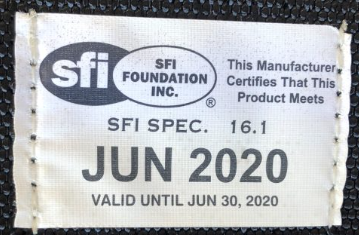Sign up now to join the JEGS email newsletter and be the first to learn about new products, special deals and e-mail only offers!

If you’re planning on hitting the race track in 2024 or entering any sanctioned auto racing events, then you’ll definitely need a race seat belt harness.
However, not just any racing seat belts will do, as most tracks and professional events require a harness approved by either the Fédération Internationale de l'Automobile (FIA) or SEMA Foundation, Inc. (SFI).
These organizations set the standards for racing safety equipment, ensuring that every harness meets strict criteria for strength, durability, and performance under extreme conditions.
To help you choose the right race harness approved for your needs, this article reviews everything you need to know about the different requirements and expiration regulations.
Let’s get started.
Unlike traditional 3-point lap/shoulder seat belts in today's passenger cars, racing harnesses feature 4, 5, and 6 points of contact.
These extra-point setups are important as they help spread the impact force more evenly across the body and hold the driver more securely in place during high-speed maneuvers or in the event of an accident or rollover.
But that’s not all; FIA or SEMA-approved racing harnesses are also regulated by the durability of their material, their UV resistance, and what type of locking/latching mechanism is used.
Below, we’ll review more about the FIA, SFI, and their requirements so you know what to expect in 2024.
FIA sets rigorous standards for racing safety equipment, including racing seat belts. Under FIA standard 8853/98, each component of a racing harness must feature an FIA tag indicating its expiration year, which begins five years from January 1st following the manufacture date.
For instance, a harness made in 2015 will be tagged as expiring after 2020, potentially offering six years of use if acquired early in the year.
FIA mandates that belts must be replaced if the homologation tag is outdated or missing, although not all tags on the belt need to match in expiration date but must remain valid and legible.
FIA-approved belts, typically made from durable polyester due to its high UV resistance and minimal stretch, are required for sedan style and open wheel formula cars.
These belts undergo stringent tests for breaking loads, elongation rates, and abrasion resistance to ensure maximum safety. Re-webbing of FIA belts is prohibited to maintain integrity and compliance with safety standards.
SFI offers a range of standards for racing seat belts, including specifications 16.1, 16.2, 16.5, and 16.6, catering to different racing environments.
SFI belts must pass tests for elongation, breaking strength, and body block resistance, with added requirements based on the specific standard, such as micro-slip and abrasion resistance for 16.5 and 16.6.
SFI-certified belts display tags indicating manufacture dates, and they are valid for two years, reflecting the conditions they may endure, especially in drag and circle track racing.
Unlike FIA, SFI allows for re-webbing under standards 16.1 and 16.2 but not for 16.5 and 16.6, which are used under more stringent conditions.
The two-year safety harness expiration is due to factors like material degradation, especially for nylon webbing used in many SFI belts, which can lose tensile strength from UV exposure and other elements. This policy ensures that belts continue to meet safety standards even in the demanding conditions typical of SFI-regulated events.
Sign up now to join the JEGS email newsletter and be the first to learn about new products, special deals and e-mail only offers!

Understanding and adhering to racing harness regulations is important for safety and compliance in motorsport activities.
Below, we’ll share some key points to help you manage the regulatory details:
Remember, proper compliance with racing harness regulations not only ensures your safety on the track but also upholds the integrity of the sport. Regular updates and checks on your equipment are important steps in your racing preparation.
When choosing a race harness for your next track day or sanctioned event, it's important to consider several factors to ensure safety, comfort, and compliance:
For a deeper dive into choosing a race harness, check out our detailed buying guide.
You should now have a full understanding of the different rules and regulations surrounding racing seat belts. From material type to abrasion resistance, by sticking with racing harnesses approved for your specific type of autosport, you’re sure to have a safe, legal, and fun day at the track.
For all your automotive needs, consider JEGS, a leading supplier of performance auto parts, including SFI and FIA-certified racing harnesses.
Complete your order online and have your products sent straight to your garage. Still have questions? Contact our team today.



